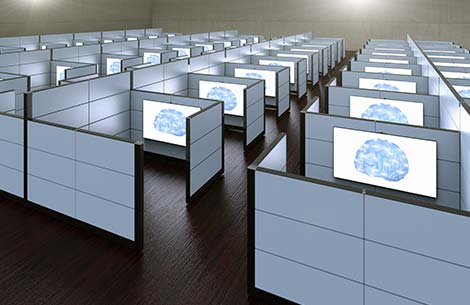When you’re the person who makes the seating chart, you have a lot of power and also a serious responsibility to optimize a functioning workplace.
There’s a whole Myers-Briggs personality chart of different needs to consider when deciding who sits where and in what kind of working environment. You’ve got your introverts who suffer in an open area with no control over chatty co-workers; then there are the social climbers who take their office placement as a status symbol and will claw their way to the best space. Plus, don’t forget the executives who only give attention for the top boss and their own direct reports, not their peer leadership group.
It’s a sure recipe for headaches when it comes to the intersection of people’s comfort zones and their assigned roles in your company. This is what’s behind the “open plan” workplace—to make communication easier, interaction more democratic, and isolation less possible. Sounds idyllic, doesn’t it?
That space-age, space-sharing workplace of planners’ dreams all too often winds up as a bunch of disgruntled cubicle dwellers permanently hooked in to AirPods and slipping into stairwells or conference rooms every time they have to make a phone call.
There may be workplaces where being in a truly open-plan setup is successful. But yours may not be one of them. Let’s face it, people like their personal space, somewhere to make the occasional phone call, and somewhere they have control over.
To deal with this problem, remember that love is good business. In other words, strive to create an environment that your employees will love working in. And since your folks, by definition, are unique, there’s no one floor plan that will work for everyone.
Let yourself feel what your employees are feeling. Validate their need to have a work environment that makes them comfortable, and even special. Look for the way to exceed people’s expectations. Here are five suggestions to get you closer to the rose petals and farther away from the thorns.
Respect introverts and deep concentrators by giving them as much privacy as possible.
That doesn’t mean the file clerk gets the corner office, but if yours is introverted, that file clerk should get an opportunity to choose the cubicle on the end or a workspace with ready access to a conference room nearby that has a door that closes.
Put people who need help near people who are ready and willing to give help.
The person’s immediate neighbors—closer than two rows away—are the people who account for the majority of their interactions during the work day. So try placing the experienced Baby Boomer in Suite 101 very close to the eager intern. It really does rub off with close contact! Conversely, think long and hard about your marginal or disgruntled people, if any. (You should be thinking about them anyway, and getting them help. But meanwhile, don’t put them where they have a lot of proximity to impressionable colleagues.)
Offer some “sanctuary space” within an otherwise open office.
The latest trend in Manhattan-based companies is the phone-booth-style pod, where people can go to conduct phone interviews, video calls, or other noisy or private conversations. They’re so popular that lines tend to form outside them. This might seem like a move that reduces collaboration and neighborly behavior, but in fact it gives people a needed break so they can get back to the group experience feeling refreshed.
Consider the impact of nature and light on productivity and general happiness.
A recent poll by office design company Truspace found that people are 15 percent more likely to have a feeling of general “well-being” at work if there are natural features such as plants and water near where they sit. Nearly half of companies don’t have natural light access for their workers, and 58 percent have no live plants in the workspace, the study found. Meanwhile, it found that if they made that simple change, they could expect a 6 percent rise in productivity and a 15 percent increase in creativity. Get some plants and water them, and see how else you can make colors, decor, and seating plans feel more natural.
Make your workplace more mobile, unplugged, and movable.
A Steelcase study found that more than 80 percent of employees use fixed technology such as landline phones and desktop computers in their jobs. That same study found that workers who are able to choose the location where they perform various tasks are far, far more likely to feel “highly engaged” in their jobs. It goes without saying, then: make it possible for people to have control over their surroundings, to whatever extent you can. Show your people that you know that, acknowledge it, and care about what solutions you can find together.
The bottom line is, millennial and Gen-Y workers are used to going everywhere with their earbuds in. They can block out distractions. But do you want them to be blocking out their co-workers? Not so much. The key, then, is to give them the opportunity to have personal space, and make it appealing to their senses. That way, they come back to the actual, you know, human interaction portion of the job with new patience and openness.
Not Authorized
You are currently not authorized to access this section.
Please contact your Administrator to change your authorization settings.
Please contact your Administrator to change your authorization settings.

How to Invite Collaboration Without Inviting People to Live in Airpods On a Cubicle Farm
June 4, 2019

